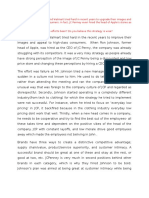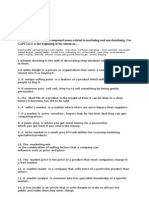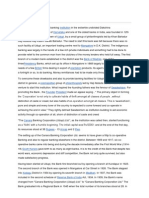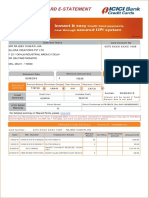Marlon Pacheco Module 5 - Case MKT501 Strategic Marketing (FAL2014-2) Dr. Todd Senft Trident University
Marlon Pacheco Module 5 - Case MKT501 Strategic Marketing (FAL2014-2) Dr. Todd Senft Trident University
Uploaded by
Michael MillerCopyright:
Available Formats
Marlon Pacheco Module 5 - Case MKT501 Strategic Marketing (FAL2014-2) Dr. Todd Senft Trident University
Marlon Pacheco Module 5 - Case MKT501 Strategic Marketing (FAL2014-2) Dr. Todd Senft Trident University
Uploaded by
Michael MillerOriginal Description:
Original Title
Copyright
Available Formats
Share this document
Did you find this document useful?
Is this content inappropriate?
Copyright:
Available Formats
Marlon Pacheco Module 5 - Case MKT501 Strategic Marketing (FAL2014-2) Dr. Todd Senft Trident University
Marlon Pacheco Module 5 - Case MKT501 Strategic Marketing (FAL2014-2) Dr. Todd Senft Trident University
Uploaded by
Michael MillerCopyright:
Available Formats
Running Head: CASE
Marlon Pacheco
Module 5 Case
MKT501 Strategic Marketing (FAL2014-2)
Dr. Todd Senft
Trident University
CASE
2
Free Offers and Pricing
Case
Company Introduction
A retail store which has been established to offer several kinds of consumer goods in
product categories that have been different to each other is known as a department store.
Department stores have been selling home appliances, cosmetics, furniture, clothing, toys,
toiletries, gardening, sports goods, paint along with other product lines for example stationary,
books, electronics, jewelry, baby products, pet products, and many more. In 1846, Marble Palace
was established by Alexander Turney Stewart, who offered retail merchandise of Europe on fixed
prices (Kruger, 2010). Moreover, he offered free entrance to the people he thought would be
potential customers. Soon after Alexander, Rowland Hussey found Macys as a store for dry
goods and the chain went on.
JCPenny has been a chain of department stores in America which is a mid-range chain
with the name of company J. C. Penny and Company, Inc. the company has been operating more
than thousand department stores in all the fifty states of the U.S. as well as in Puerto Rico
(Kruger, 2010). Along with retailing conventional merchandise, JCPenny stores have also been
leasing departments such as Seattle Best Coffee, optical centers, Sephora, jewelry repair, and
portrait studios. JCPenny has been the second largest department store retailer in America and
most of its stores has been located in suburban shopping malls. However, most of the stores of
JCPenny had been located in downtown areas before 1966 but the emergence of shopping malls
the store changed its location and moved to shopping malls (Kruger, 2010).
Ron Johnsons Pricing Strategy
Ron Johnson joined JCPenny with a bold vision and at the time of joining the firm he
said that the department store n had a chance to regain its status as a leading store in the market
and the period of true innovation now has been started (Reingold, 2012). According to Johnson,
CASE
the pricing policy of JCPenny needed to be changed so he curtly tussled pricing policy at
JCPenny which had already been dubious and offered discounts, coupons, along with heavy
promotions. Furthermore, he offered more fascinating merchandises from lines such as Joe Fresh
and Martha Stewart, at best reasonable prices (Reingold, 2012).
Johnsons Pricing Strategy Failed
Soon after the introduction of promotions, people started noticing that no sales
experiment and no coupons had been failing to attract consumers and sales collapsed in the priod
of early 2012and entering into the summers of the same year even the CEO of JCPenny, Ron
Johnson realized that a big mistake had been committed by the store. There have been several
reasons for the failure of the pricing strategy offered by Johnson (Reingold, 2012).
The first biggest mistake made by the former CEO, was that he did not test his ideas in
advance and he did not even ask his consumers that what they had been enjoying at JCPenny the
most. No survey had been done before making decisions and when he was asked to test the idea
on a limited basis he turned down the offer saying that he did not test at Apple. His pricing policy
did not include the terms like sale or clearance so it made people ore confused about sales
(Reingold, 2012).
The second biggest mistake was that he alienated core customers. Soon after removing its
beloved sales and coupons, the company focused increasingly on making JCPenny a trendy
destination for consumers and making their shopping experience delighted with introducing
boutique store within their stores so most of the loyal customers of JCPenny felt that they were
no longer the target market of the company and returning of sales did not bring those consumers
back to the store (Reingold, 2012).
Another big mistake was totally misreading the brand of JCPenny. Johnson envisioned
rows of boutique and coffee bars in the store because he wanted people to feel a bazaar shopping
experience. However, in early era of Johnson critics started to point the fact that JCPenny has
CASE
been different than Apple store but he failed to understand any concept related to change the
store. Basically Johnson did not seem to respect or like the store and the match of JCPenny and
Johnson resulted to be a horrible one (Reingold, 2012).
Johnson could have done better
Johnson could have done much better than what he actually did but since he was coming
from Apple he was too sure about his success at JCPenny too (Reingold, Jones & Kramer, 2014).
The first mistake he made was not testing his ideas of introducing coupons and promotions
without the term sale or clearance making people too confused and dubious about the
promotions. He actually did not study the store and history of the store before implementation of
his plans since studying the nature of business and the history of any company has been
extremely important before applying new policies. Along with studying the history of the
company it is equally important to study the consumer behavior as well as surveying the needs of
customers (Reingold, Jones & Kramer, 2014). The suggestions and feedbacks have also been
very important before deciding future principles of the company. Johnson at JCPenny did not do
any of the two mentioned above which resulted in a complete failure of the pricing strategy of
the company. Moreover, he would not have introduced the boutiques within the store as it made
most of the loyal customers feel that the store no longer wanted to retain them so they left the
store and switched to another, even sale promotions did not make them feel better and they did
not come back (Reingold, Jones & Kramer, 2014).
Comparison
The pricing policies presented by Ron Johnson had much of coupons and sales
promotions but the pricing policy had now changed and the use of coupons had been reduced
making people attract than before. However, still people have been dubious about the
promotional strategy at JCPenny because they have an idea that the prices and promotional offers
CASE
at JCPenny had been fake. It would take a bit of time to eliminate the wrong perception of people
about the store and return them to store as loyal customers of JCPenny (Mattioli, 2012).
CASE
References
Kruger, D. D. (2010). Idaho and the Development of the JCPenney Chain. Idaho Yesterdays,
51(2).
Mattioli, D. (2012, January 26). J.C. Penney chief thinks different. Wall Street Journal.
Reingold, J. (2012, March 19). Retail's new radical. Fortune. Retrieved from
http://management.fortune.cnn.com/2012/03/07/jc-penney-ron-johnson/
Reingold, J., Jones, M., & Kramer, S. (2014). How to fail in business while really, really trying.
Fortune, 169 (5), 80.
You might also like
- Trader Joe's Case SolutionDocument7 pagesTrader Joe's Case SolutionsmeilyNo ratings yet
- Jcpenney Fair and Square CaseDocument3 pagesJcpenney Fair and Square CasegNo ratings yet
- JC Penney Group Project 042513 V 2Document35 pagesJC Penney Group Project 042513 V 2Pookguy100% (2)
- Final ExamDocument7 pagesFinal ExamKamrul Hasan ShaonNo ratings yet
- JC Penny Case StudyDocument6 pagesJC Penny Case StudyJune WethingtonNo ratings yet
- Consumer Attitude Towards Johnson & Johnson Baby Care Products in Shimoga - .Document96 pagesConsumer Attitude Towards Johnson & Johnson Baby Care Products in Shimoga - .yeomacha63% (16)
- Cross Cultural Case Study-1Document2 pagesCross Cultural Case Study-1Avinash Singh100% (1)
- Product Life Cycle of CadburyDocument11 pagesProduct Life Cycle of CadburyDevhoot Rane100% (3)
- OCRA E-Gaming BrochureDocument20 pagesOCRA E-Gaming BrochurejpamcicNo ratings yet
- Interbrand: Interbrand's Annual Ranking of 100 of The World's Most Valuable Brands (2002)Document3 pagesInterbrand: Interbrand's Annual Ranking of 100 of The World's Most Valuable Brands (2002)designeducationNo ratings yet
- When Old Is New and New Is OldDocument13 pagesWhen Old Is New and New Is OldHABIBUL WAHID HARMADANNo ratings yet
- North Campus: Final Examination Spring Semester 2020Document4 pagesNorth Campus: Final Examination Spring Semester 2020Syeda Fakiha AliNo ratings yet
- J. C. Penney Company Inc.: Group A+Document14 pagesJ. C. Penney Company Inc.: Group A+Milean NorNo ratings yet
- Jcpenney, Inc: A Case Study About The Impact of Rebranding On Internal and External CommunicationDocument5 pagesJcpenney, Inc: A Case Study About The Impact of Rebranding On Internal and External Communicationsibina.ac sibina.aniyachalilNo ratings yet
- JC PenneyDocument3 pagesJC PenneyRayudu Surya Teja Srinivas PGP 2022-24 BatchNo ratings yet
- JC Penny - Strategia de Rebranding 2014Document14 pagesJC Penny - Strategia de Rebranding 2014Teodora RădulescuNo ratings yet
- JCPenny CaseDocument14 pagesJCPenny CaseSushant Bhasin100% (3)
- JC PenneyDocument12 pagesJC PenneyVinod Nair100% (1)
- Is JCPenney Killing Itself With A Failed StrategyDocument3 pagesIs JCPenney Killing Itself With A Failed StrategyEmmanuelNo ratings yet
- Q1 (JC Penney)Document3 pagesQ1 (JC Penney)Mohamad ZaemNo ratings yet
- Chapter+9 Trader+Joes Case+Study+SolutionDocument6 pagesChapter+9 Trader+Joes Case+Study+SolutionTushar KumarNo ratings yet
- J.C. Penney's "Fair and Square" Pricing StrategyDocument6 pagesJ.C. Penney's "Fair and Square" Pricing StrategySachin KandloorNo ratings yet
- Revamping JC Penney CaseDocument16 pagesRevamping JC Penney CaseTamara Fraser100% (1)
- JcpenneymarketingplanDocument29 pagesJcpenneymarketingplanapi-25223427150% (2)
- JC Penney Retail Case Study: Group Project - Retail MarketingDocument6 pagesJC Penney Retail Case Study: Group Project - Retail MarketingLakshmi SrinivasanNo ratings yet
- Sales ManagementDocument2 pagesSales ManagementTomiris TulegenovaNo ratings yet
- Change ManagementDocument1 pageChange Managementyukti jaiswalNo ratings yet
- J.C. Penney Company (Click Here To View in Scribd Format)Document13 pagesJ.C. Penney Company (Click Here To View in Scribd Format)interactivebuysideNo ratings yet
- Logo TransitionDocument13 pagesLogo TransitionRaana SheikhNo ratings yet
- Consumer Behavior Cases: Case 1: Xyz CorporationDocument5 pagesConsumer Behavior Cases: Case 1: Xyz CorporationMohammad Ali KazanNo ratings yet
- In Order To Discuss The Drucker's Quote, It Would Be Good To Start From The History of MarketingDocument4 pagesIn Order To Discuss The Drucker's Quote, It Would Be Good To Start From The History of MarketingwidpramNo ratings yet
- Analysis of Ron Johnson: Bill Ackman, The Hedge-Fund Tycoon Who Recruited Johnson To Take Over at JCDocument2 pagesAnalysis of Ron Johnson: Bill Ackman, The Hedge-Fund Tycoon Who Recruited Johnson To Take Over at JCansm businessNo ratings yet
- MCDONALDDocument8 pagesMCDONALDNguyễn Phúc Huy KhangNo ratings yet
- Assignment 3Document3 pagesAssignment 3jade galligoNo ratings yet
- Modern MarketingDocument12 pagesModern MarketingPriyanka Trivedi100% (1)
- Retail AssignmentDocument35 pagesRetail Assignmentapi-316655900No ratings yet
- Company Background: Trader Joe's Written Case Analysis Key FactsDocument5 pagesCompany Background: Trader Joe's Written Case Analysis Key FactsDominique Andrea CasiñoNo ratings yet
- A Degree in a Book: Marketing: Everything You Need to Know to Master the Subject - in One Book!From EverandA Degree in a Book: Marketing: Everything You Need to Know to Master the Subject - in One Book!No ratings yet
- Chapter 4 - Mini CaseDocument3 pagesChapter 4 - Mini CaseAlexNo ratings yet
- Group 5 Performance Task (Deconstructing Media Messages)Document4 pagesGroup 5 Performance Task (Deconstructing Media Messages)Ma. Rhona Faye MedesNo ratings yet
- INGLESE B2 ()Document13 pagesINGLESE B2 ()d.angio2003No ratings yet
- Questions Mentioned Above) : Take-Aways of The Week: What Are Your Two Personal Take-Aways (Tas) AboutDocument3 pagesQuestions Mentioned Above) : Take-Aways of The Week: What Are Your Two Personal Take-Aways (Tas) AboutajboothNo ratings yet
- Đề Thi Thật - IELTS Reading Ngày 30.3.2024Document24 pagesĐề Thi Thật - IELTS Reading Ngày 30.3.2024Thanh VõNo ratings yet
- MODULE-I Company Orientation - Marketing ConceptDocument4 pagesMODULE-I Company Orientation - Marketing ConceptSamuNo ratings yet
- ASSIGNMENT 1: Please Read Chapters 1 and 2 of Kotler and Armstrong and Answer The FollowingDocument3 pagesASSIGNMENT 1: Please Read Chapters 1 and 2 of Kotler and Armstrong and Answer The FollowingIrrah FelipeNo ratings yet
- Obviously-Awesome April-Dunford Summary and WorksheetDocument15 pagesObviously-Awesome April-Dunford Summary and WorksheetpedrolucacopyNo ratings yet
- Marketing Mix - ExercisesDocument53 pagesMarketing Mix - ExercisesNeiyla ShortcakeNo ratings yet
- Marketing MixDocument52 pagesMarketing MixNeiyla Shortcake100% (1)
- Answers To JC Penney CaseDocument3 pagesAnswers To JC Penney CaseYza Belle Soldevilla VegoNo ratings yet
- De Thi IELTS Reading 30 - 3 - 2024Document24 pagesDe Thi IELTS Reading 30 - 3 - 2024ARiFin MoHaMedNo ratings yet
- Pepsi's TV Commercial: Student's Name Institutional Affiliation DateDocument12 pagesPepsi's TV Commercial: Student's Name Institutional Affiliation DateOnline WriterNo ratings yet
- Steve Jobs MarketingDocument1 pageSteve Jobs MarketingAnurag DoshiNo ratings yet
- Day 19 Passage 1 Why Ideas FailDocument3 pagesDay 19 Passage 1 Why Ideas FailChadNo ratings yet
- FinalDocument8 pagesFinalNafisaRafaNo ratings yet
- Marketing Management DoneDocument11 pagesMarketing Management DonePramit Saran0% (2)
- How Marketing Changed Over The Past Half-CenturayDocument4 pagesHow Marketing Changed Over The Past Half-Centuraydeepakreddy849No ratings yet
- 4200 (A)Document11 pages4200 (A)ajaymanchandaNo ratings yet
- Marketing Essential: AssignmentDocument21 pagesMarketing Essential: AssignmentlaturtleNo ratings yet
- Jcpenney Research PaperDocument6 pagesJcpenney Research Paperpimywinihyj3100% (1)
- Creative Objectives and Methods AnalysisDocument21 pagesCreative Objectives and Methods AnalysisMatt MeierNo ratings yet
- Branding For Success - Achieve Business Success Through The Right Branding StrategyFrom EverandBranding For Success - Achieve Business Success Through The Right Branding StrategyNo ratings yet
- Citizen Brand: 10 Commandments for Transforming Brands in a Consumer DemocracyFrom EverandCitizen Brand: 10 Commandments for Transforming Brands in a Consumer DemocracyNo ratings yet
- No Gap Location Change Concert VenueDocument8 pagesNo Gap Location Change Concert VenueMichael MillerNo ratings yet
- HondaDocument6 pagesHondaMichael MillerNo ratings yet
- Appeal Memos LHRCDocument10 pagesAppeal Memos LHRCMichael MillerNo ratings yet
- Hs-304 Business Communication and EthicsDocument1 pageHs-304 Business Communication and EthicsMichael MillerNo ratings yet
- PTCL Evo Activation Guide: For StudentsDocument6 pagesPTCL Evo Activation Guide: For StudentsMichael MillerNo ratings yet
- AssignmentDocument1 pageAssignmentMichael MillerNo ratings yet
- Book 1Document2 pagesBook 1Michael MillerNo ratings yet
- Model Answer: ObjectivesDocument2 pagesModel Answer: ObjectivesMichael MillerNo ratings yet
- Concept Check Quiz: First SessionDocument27 pagesConcept Check Quiz: First SessionMichael MillerNo ratings yet
- Spring Semester 2014 Third Year Civil (Batch 2011-2012)Document1 pageSpring Semester 2014 Third Year Civil (Batch 2011-2012)Michael MillerNo ratings yet
- EF-522 - Assignment - Decision ScienceDocument3 pagesEF-522 - Assignment - Decision ScienceMichael Miller0% (1)
- E - Tests For CE - 310 Fluid Mechanics IIDocument4 pagesE - Tests For CE - 310 Fluid Mechanics IIMichael MillerNo ratings yet
- International Business Transaction EssayDocument18 pagesInternational Business Transaction EssayeleshoNo ratings yet
- Guest List - Mission To Paraguay - May 28Document2 pagesGuest List - Mission To Paraguay - May 28Jackie TorresNo ratings yet
- Bmt3004-Managing Family Business: FALL SEMESTER: 2021-22 Digital Assignment-10Document7 pagesBmt3004-Managing Family Business: FALL SEMESTER: 2021-22 Digital Assignment-10Vasu Dev KanchetiNo ratings yet
- Worksheet in SAPBIBW Scope Document 2020Document24 pagesWorksheet in SAPBIBW Scope Document 2020RajeshNo ratings yet
- Irene Torres - Disa Riliana Pakpahan - Shakti Shikhar Mim Ib Fi - Ie Business SchoolDocument17 pagesIrene Torres - Disa Riliana Pakpahan - Shakti Shikhar Mim Ib Fi - Ie Business SchoolShakti ShikharNo ratings yet
- 21 Preventive Maintenance Aa PDFDocument20 pages21 Preventive Maintenance Aa PDFMaleficaruMTNo ratings yet
- Brito v. Dianala DigestDocument2 pagesBrito v. Dianala DigestErla ElauriaNo ratings yet
- SAPM Assignment For MBADocument2 pagesSAPM Assignment For MBARahul AroraNo ratings yet
- History of Corp BankDocument4 pagesHistory of Corp BankSharath ShastriNo ratings yet
- Dormer Catalouge Data Sheet A920Document5 pagesDormer Catalouge Data Sheet A920M100S2No ratings yet
- Wip BirlaDocument37 pagesWip BirlaSneha YadavNo ratings yet
- Accounting For Overhead CostsDocument2 pagesAccounting For Overhead CostsLijobethNo ratings yet
- H.t.no: 098-06-0102Document71 pagesH.t.no: 098-06-0102Sagar Paul'gNo ratings yet
- Motta, M., "E. C. Merger Policy and The Airtours Case"Document25 pagesMotta, M., "E. C. Merger Policy and The Airtours Case"Ana Maria SimionNo ratings yet
- Winding Up of CompaniesDocument5 pagesWinding Up of CompaniesDickson Tk Chuma Jr.No ratings yet
- Android Hacker-S HandbookDocument2 pagesAndroid Hacker-S HandbookJack LeeNo ratings yet
- Passbookstmt PDFDocument3 pagesPassbookstmt PDFPáRth JhãNo ratings yet
- CASH-DISBURSEMENT-REGISTER-revision JAN 2020Document1 pageCASH-DISBURSEMENT-REGISTER-revision JAN 2020Roanne Anuran Mendoza80% (5)
- Generation Investment Management LLP 13F-HR Effective 11/10/09, For 9/30/09, On 11/10/09Document3 pagesGeneration Investment Management LLP 13F-HR Effective 11/10/09, For 9/30/09, On 11/10/09api-19882241No ratings yet
- Artesianaustralianventurecapitalfund 170819143939Document31 pagesArtesianaustralianventurecapitalfund 170819143939xxNo ratings yet
- Bsa Qualifying Examination Permit 2018Document2 pagesBsa Qualifying Examination Permit 2018api-194241825No ratings yet
- 41 - Outreach Request - IAS 2 IAS 16 "Core Inventories"Document3 pages41 - Outreach Request - IAS 2 IAS 16 "Core Inventories"Socola ĐắngNo ratings yet
- The NEW 2011 ACCA Professional Qualification SyllabusDocument7 pagesThe NEW 2011 ACCA Professional Qualification SyllabusNyNy YongNo ratings yet
- Feasibility Study (Draft)Document33 pagesFeasibility Study (Draft)Arianne Lou-Ella C. LagorraNo ratings yet
- Ifrsresources (Dec 2012) PDFDocument10 pagesIfrsresources (Dec 2012) PDFKania NiaNo ratings yet
- Member List 2017-18 PDFDocument28 pagesMember List 2017-18 PDFJagadamba RealtorNo ratings yet





































































































